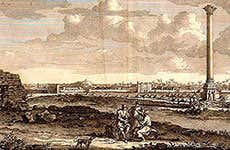
Ancient Egyptian Dynasties
Between 3100 BCE and 332 BCE, Egypt was ruled by thirty-one different dynasties, which are classified into Old, Middle and New Kingdoms.
Early Dynastic Period
The first two dynasties of Ancient Egypt span the years between 3100 BCE, when Menes (also known as Narmer) unified Upper and Lower Egypt, and 2650 BCE.
Old Kingdom
Between 2635 to 2155 BCE, the third to sixth dynasties of Egypt, or the Old Kingdom, was considered a golden age. Free from wars, this was a period of pleasing the Pharaohs, and it has gained the name "the era of the pyramids" for the mass construction of these incredible funerary structures.
The earliest built were those found at Saqqara, northwest of the then-capital Memphis, including the famous Step Pyramid of Djoser. Later, the three Great Pyramids of Giza, still amongst some of the largest structures ever made by man, were constructed.
From the sixth dynasty until the tenth, the Pharaohs began to lose their power and influence, and the unity of the country was threatened. Often referred to as a "dark period" in Ancient Egyptian history, it was marked by competing kings, political upheaval and the destruction of many temples and their artwork.
Middle Kingdom
The period between 2061 and 1785 BCE, ruled by the 11th to the 13th dynasties, is known as the Middle Kingdom. The eleventh dynasty marked the start of Thebes, on which the modern city of Luxor was built, as capital of Egypt.
The high points of this era saw Egypt expanding south into Nubia and enjoying great economic prosperity, however the thirteen dynasty saw its decline, with the arrival of the Hyksos, the "rulers of foreign lands", from Asia. They ruled the country for several dynasties until Ahmose I, the first Pharaoh of the 18th dynasty, waged war on them.
New Kingdom
From 1551 until 1080 BCE, the New Kingdom - also called the Egyptian Empire - encompassed the 18th to 20th dynasties. After the Hyksos were chased out, Thebes became capital again, and the ensuing centuries saw some of Ancient Egypt's most famous Pharaohs, including Hatshepsut, Tutankhamun, Thutmose III (the "Napoleon of Egypt") and eleven different rulers called Ramesses.
During the New Kingdom, Egypt conquered Nubia and constructed the temples of Abu Simbel. Following the reign of Ramesses II, who lived for 90 years and had more than 180 children, conflict between his heirs lead to the Empire's deterioration.
Late Dynasties
1080 until 332 BCE saw the succession of the 21st to the 31st dynasties and further decline and fragmentation of the nation, being invaded by the Persians in 525 BCE, and finally falling under the conquest of Alexander the Great in 332 BCE, marking the start of Greco-Roman Egypt.

